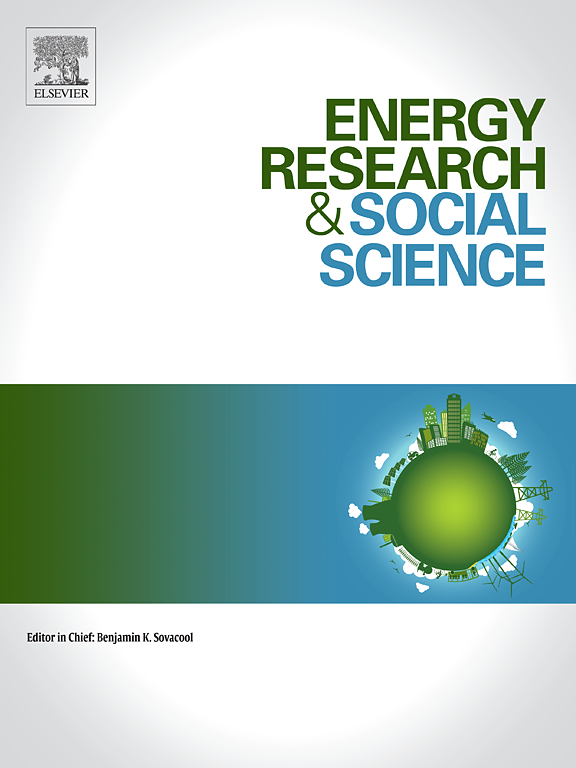Heating and cooling places: Justice claims on energy behind the front door
IF 6.9
2区 经济学
Q1 ENVIRONMENTAL STUDIES
引用次数: 0
Abstract
Answers to ‘what energy is for’ might differ between professionals and residents living in lower-income neighborhoods. By combining ethnographic interviews and creative methods, we engage with residents to analyze justice claims in relation to places for keeping warm and cool in and around the home. Justice claims are normative answers to questions concerning justice. For instance, answers to questions such as: which and whose places for keeping warm and cool should (not) exist, and whose energy consumption should (not) reduce. We highlight three ways in which residents' justice claims emerge from places for keeping warm and cool. First, we discuss how places are perceived, conceived and lived in diverse ways. For residents, place does not only concern the size of the home and its location, but also e.g., the layout of the home, implicated objects, the diverse (human) bodies involved, the sensorial and lived experience. Different justice claims emerge from diverse configurations of places for keeping warm and cool. Second, the temporal dynamics of places for keeping warm and cool connect to justice claims. Instead of focusing on heating and cooling static rooms or houses, we propose a focus on heating and cooling dynamic places. Lastly, residents adjust places in and around their rented home. Meanwhile, an empty standardized home is easier to renovate but contrasts with reality. This tension leads to emerging justice claims. Current renovation standards diminish possibilities for tenants to adjust places for keeping warm and cool. Failing to take residents' situated justice claims seriously, risks misrecognition.
供暖和制冷场所:正义要求前门后面的能源
对于“能源是用来干什么的”这个问题,专业人士和生活在低收入社区的居民的回答可能会有所不同。通过结合民族志访谈和创造性的方法,我们与居民接触,分析与家庭内外保暖和凉爽场所有关的正义主张。正义主张是对正义问题的规范性回答。例如,对以下问题的回答:应该(不)存在哪个和谁的保暖和降温场所,应该(不)减少谁的能源消耗。我们强调了三种方式,居民的正义主张出现在保暖和凉爽的地方。首先,我们讨论了如何以不同的方式感知、构思和居住地方。对于居民来说,场所不仅涉及住宅的大小和位置,还涉及住宅的布局、涉及的物体、涉及的不同(人类)身体、感官和生活体验。不同的保暖和降温场所的不同配置产生了不同的正义主张。其次,保暖和降温场所的时间动态与正义诉求有关。我们建议将重点放在加热和冷却静态房间或房屋上,而不是放在加热和冷却动态场所上。最后,居民们会调整租住房屋内部和周围的位置。与此同时,一个空置的标准化房屋更容易装修,但与现实形成鲜明对比。这种紧张关系导致了正义诉求的出现。目前的装修标准减少了租户调整房间以保持温暖和凉爽的可能性。如果不认真对待居民的司法要求,就有被误解的风险。
本文章由计算机程序翻译,如有差异,请以英文原文为准。
求助全文
约1分钟内获得全文
求助全文
来源期刊

Energy Research & Social Science
ENVIRONMENTAL STUDIES-
CiteScore
14.00
自引率
16.40%
发文量
441
审稿时长
55 days
期刊介绍:
Energy Research & Social Science (ERSS) is a peer-reviewed international journal that publishes original research and review articles examining the relationship between energy systems and society. ERSS covers a range of topics revolving around the intersection of energy technologies, fuels, and resources on one side and social processes and influences - including communities of energy users, people affected by energy production, social institutions, customs, traditions, behaviors, and policies - on the other. Put another way, ERSS investigates the social system surrounding energy technology and hardware. ERSS is relevant for energy practitioners, researchers interested in the social aspects of energy production or use, and policymakers.
Energy Research & Social Science (ERSS) provides an interdisciplinary forum to discuss how social and technical issues related to energy production and consumption interact. Energy production, distribution, and consumption all have both technical and human components, and the latter involves the human causes and consequences of energy-related activities and processes as well as social structures that shape how people interact with energy systems. Energy analysis, therefore, needs to look beyond the dimensions of technology and economics to include these social and human elements.
 求助内容:
求助内容: 应助结果提醒方式:
应助结果提醒方式:


